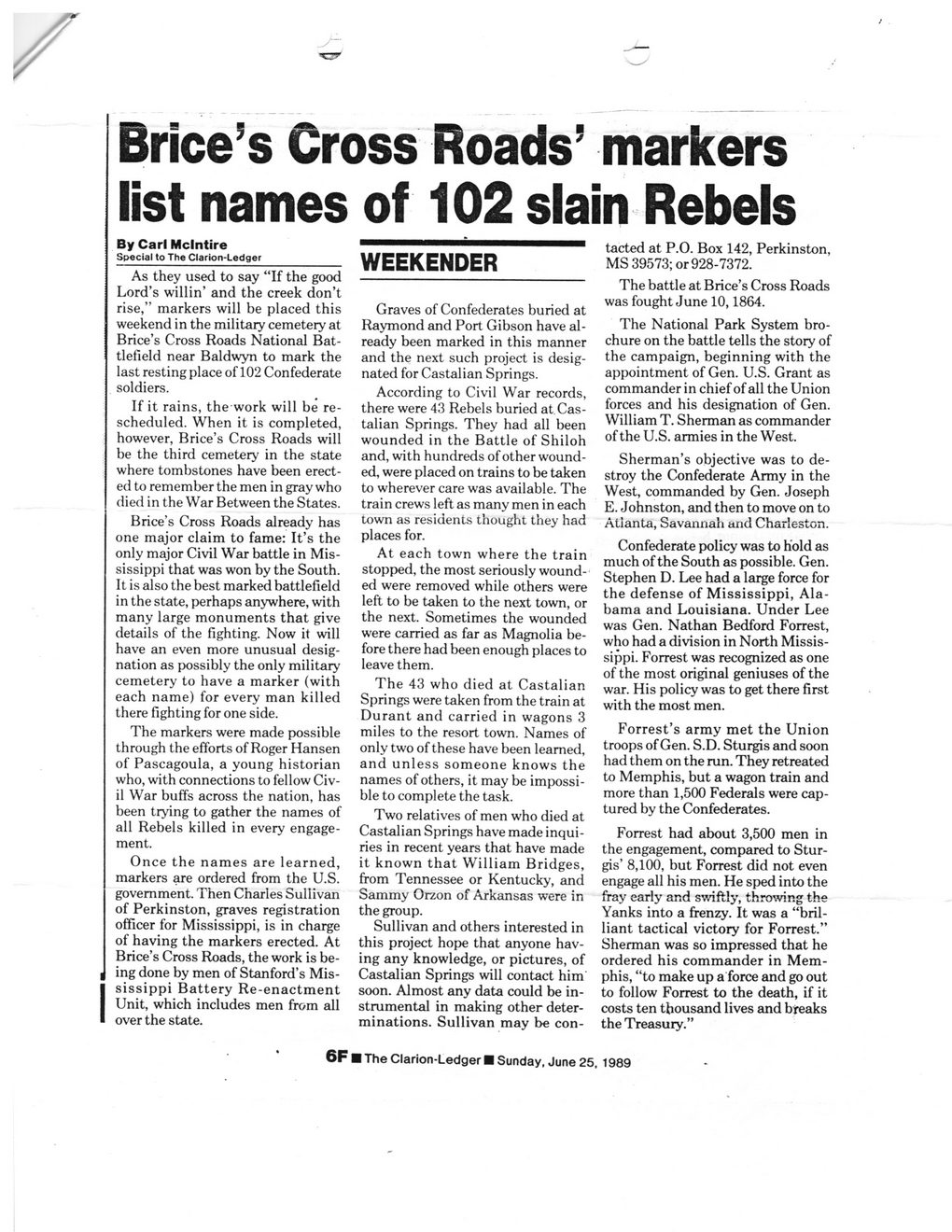This text was obtained via automated optical character recognition.
It has not been edited and may therefore contain several errors.
Brice’s Cross Roads’ markers list names of 102 slain Rebels By Carl Mclntire Special to The Clarion-Ledger As they used to say “If the good Lord’s willin’ and the creek don’t rise,” markers will be placed this weekend in the military cemetery at Brice’s Cross Roads National Battlefield near Baldwyn to mark the last resting place of 102 Confederate soldiers. If it rains, the work will be rescheduled. When it is completed, however, Brice’s Cross Roads will be the third cemetery in the state where tombstones have been erected to remember the men in gray who died in the War Between the States. Brice’s Cross Roads already has one major claim to fame: It’s the only major Civil War battle in Mississippi that was won by the South. It is also the best marked battlefield in the state, perhaps anywhere, with many large monuments that give details of the fighting. Now it will have an even more unusual designation as possibly the only military cemetery to have a marker (with each name) for every man killed there fighting for one side. The markers were made possible through the efforts of Roger Hansen of Pascagoula, a young historian who, with connections to fellow Civil Wrar buffs across the nation, has been tiying to gather the names of all Rebels killed in every engagement. Once the names are learned, markers are ordered from the U.S. government. Then Charles Sullivan of Perkinston, graves registration officer for Mississippi, is in charge of having the markers erected. At Brice’s Cross Roads, the work is being done by men of Stanford’s Mississippi Battery Re-enactment Unit, which includes men from all over the state. WEEKENDER Graves of Confederates buried at Raymond and Port Gibson have already been marked in this manner and the next such project is designated for Castalian Springs. According to Civil War records, there were 43 Rebels buried at Castalian Springs. They had all been wounded in the Battle of Shiloh and, with hundreds of other wounded, were placed on trains to be taken to wherever care was available. The train crews left as many men in each town as residents thought they had places for. At each town where the train stopped, the most seriously wounded were removed while others were left to be taken to the next town, or the next. Sometimes the wounded were carried as far as Magnolia before there had been enough places to leave them. The 43 who died at Castalian Springs were taken from the train at Durant and carried in wagons 3 miles to the resort town. Names of only two of these have been learned, and unless someone knows the names of others, it may be impossible to complete the task. Two relatives of men who died at Castalian Springs have made inquiries in recent years that have made it known that William Bridges, from Tennessee or Kentucky, and Sammy Orzon of Arkansas were in the group. Sullivan and others interested in this project hope that anyone having any knowledge, or pictures, of Castalian Springs will contact him soon. Almost any data could be instrumental in making other determinations. Sullivan may be con- tacted at P.O. Box 142, Perkinston, MS 39573; or 928-7372. The battle at Brice’s Cross Roads was fought June 10,1864. The National Park System brochure on the battle tells the story of the campaign, beginning with the appointment of Gen. US. Grant as commander in chief of all the Union forces and his designation of Gen. William T. Sherman as commander of the US. armies in the West. Sherman’s objective was to destroy the Confederate Army in the West, commanded by Gen. Joseph E. Johnston, and then to move on to Atlanta, Savannah and Charleston. Confederate policy was to hold as much of the South as possible. Gen. Stephen D. Lee had a large force for the defense of Mississippi, Alabama and Louisiana. Under Lee was Gen. Nathan Bedford Forrest, who had a division in North Mississippi. Forrest was recognized as one of the most original geniuses of the war. His policy was to get there first with the most men. Forrest’s army met the Union troops of Gen. S.D. Sturgis and soon had them on the run. They retreated to Memphis, but a wagon train and more than 1,500 Federals were captured by the Confederates. Forrest had about 3,500 men in the engagement, compared to Sturgis’ 8,100, but Forrest did not even engage all his men. He sped into the fray early and swiftly, throwing the Yanks into a frenzy. It was a “brilliant tactical victory for Forrest.” Sherman was so impressed that he ordered his commander in Memphis, “to make up a force and go out to follow Forrest to the death, if it costs ten thousand lives and breaks the Treasury.” 6F ■ The Clarion-Ledger ■ Sunday, June 25, 1989

BSL 1981 To 1990 Baldwyn-Confederate-Graves-Marked-(2)